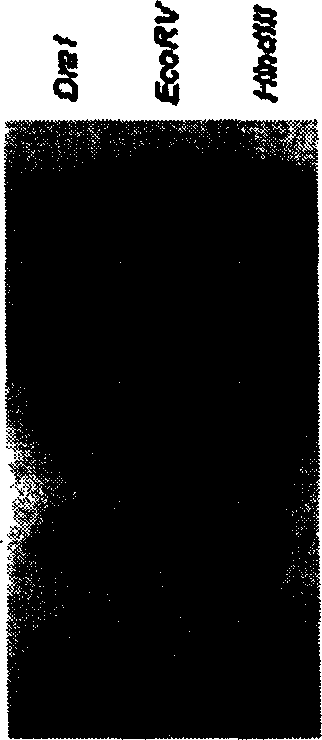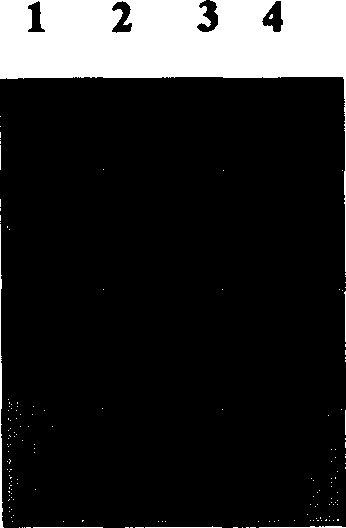Solanum lycopersicoides dun. S1Ve1 receptor protein encoding sequence and use thereof
A tomato, anti-big technology, applied in the direction of application, use of vectors to introduce foreign genetic material, plant peptides, etc.
- Summary
- Abstract
- Description
- Claims
- Application Information
AI Technical Summary
Problems solved by technology
Method used
Image
Examples
Embodiment 1
[0040] Cloning of the Receptor Protein (SlVe1) Gene of Solanum Solanum Resistant to Verticillium dahliae
[0041] 1. Plant material and RNA isolation (Plant material and RNA isolation)
[0042] The seeds of the tomato-like solanaceous line LA2386 were kindly donated by Dr. Chetelat of the C.M.Rick Tomato Genetic Resources Center (C.M.Rick Tomato Genetic Resources Center, Dept. Vegetable Crops, University of California, Davis, USA), Department of Vegetable Crops, University of California, Davis, USA. Seeds were soaked in 15% sodium hypochlorite disinfectant for 30 minutes, rinsed in sterilized distilled water with 4 changes of water for 4 hours, and then inoculated in the middle of several layers of sterilized filter paper at 25°C to germinate, and the germinated seeds were sown to a concentration of 1:1:1 In the culture tanks of loam, vermiculite and perlite, keep them at 20°C and 14h light / 10h dark conditions until they emerge and grow, and inoculate the regenerated plants wi...
Embodiment 2
[0057] Sequence Information and Homology Analysis of the Receptor Protein (SlVe1) Gene of Solanum Solanum Resistant to Verticillium dahliae
[0058] The novel tomato-like solanum anti-Verticillium dahliae receptor protein (SlVe1) full-length cDNA has a length of 3400bp (excluding polyA), and the detailed sequence is shown in SEQ ID NO.3, wherein the open reading frame is located at the 23-3175 core glycosides. The amino acid sequence encoded by SlVe1 was deduced according to the full-length cDNA, with a total of 1050 amino acid residues, a molecular weight of 116.97kDa, and an isoelectric point (pI) of 5.22. See SEQ ID NO.3 for the detailed sequence.
[0059] The full-length cDNA sequence of tomato-like Solanum anti-Verticillium dahliae receptor protein and its encoded protein were published in Non-redundant GenBank+EMBL+DDBJ+PDB and Non-redundant GenBank CDS translations+PDB+SwissProt+Superdate+ Nucleotide and protein homology searches were carried out in the PIR database, ...
Embodiment 3
[0061] Copy Number Analysis of Solanum Solanum Anti-Verticillium dahliae Receptor Protein (SlVe1) Gene in Solanum Solanum
[0062] Extract DNA from tomato-like Solanaceae leaves by conventional methods (refer to "Molecular Cloning", Sambrook et al., 1989), digest the DNA with DraI, EcoRV and HindIII respectively [13 μg (microgram) / sample], transfer the DNA to the hybridization membrane (nylon film). Using Gene Images from Amersham Pharmacia TM Contents CDP-Star TMThe labeling module (PRN3540) hybridization and detection system used the partial coding sequence of the SlVe1 gene (685 bp, obtained by PCR amplification of tomato-like Solanum cDNA using FVE685 and RVE685 as primers) as a probe to hybridize the hybridization membrane (hybridize at 60°C for 16 hours). The membrane was taken out, placed in washing solution I (1*SSC, 1% SDS), and rinsed three times at 60° C. for 15 minutes each time. Transfer to washing solution II (0.1*SSC, 1% SDS) and rinse at 60°C for 3 times, e...
PUM
| Property | Measurement | Unit |
|---|---|---|
| molecular weight | aaaaa | aaaaa |
Abstract
Description
Claims
Application Information
 Login to View More
Login to View More - R&D
- Intellectual Property
- Life Sciences
- Materials
- Tech Scout
- Unparalleled Data Quality
- Higher Quality Content
- 60% Fewer Hallucinations
Browse by: Latest US Patents, China's latest patents, Technical Efficacy Thesaurus, Application Domain, Technology Topic, Popular Technical Reports.
© 2025 PatSnap. All rights reserved.Legal|Privacy policy|Modern Slavery Act Transparency Statement|Sitemap|About US| Contact US: help@patsnap.com



